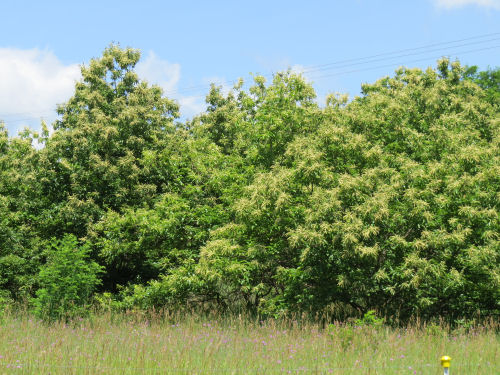A few years ago, I was pretty excited to show you that I found a mature American Chestnut on the Finger Lakes Trail in New York. It even produced fruit.
The inner loop of the Dry Hill Trail that I hiked last weekend is called the Chestnut Loop because there are many sprouts of Chestnut Trees. These are all offspring of native American Chestnut trees that were planted by early settlers. The natural range of the tree does not extend this far north. Almost all the American Chestnut trees were killed by a fungal blight in the early part of the 20th Century. The trees still try to sprout from old stumps and roots, but rarely live more than a few years. Here's one that it giving it the old college try.

Sadly, this is what happens. Instead of growing into tall trees, they turn into weedy clumps that die before they are ten years old.

Supposedly, before the big die-off, the Chestnut accounted for about a quarter of all trees in the eastern forests, with the natural range being on the west and north edges of the Appalachian Mountains. The nuts were the main food source for many animals, the way acorns are today. Between 3 and 4 billion trees died. It's hard to imagine how different the forests must have been back then. Or how different they will become. In another 50 years, the Ash will all be gone from today's forests, and the Beech will be well on their way out too, thanks to the emerald ash borer and beech bark fungus.
But Chestnut trees are really showy when in flower. They would have made the woods look quite different.
There are 600-800 mature Chestnuts that have survived in Missaukee County, Michigan (just east of Cadillac), and some on Beaver Island. The blight does not like the colder climate of the north, and most living mature trees are in areas with cold winters. That said, a few remaining trees have been found in Kentucky, New Hampshire, Tennessee, Georgia, Wisconsin, Alabama, Ohio, Pennsylvania, Virginia, and planted ones in Oregon, Nova Scotia and Ontario.
There are several foundations working to crossbreed resistant trees or make trees more genetically resistant to the fungus.
So, where I'm going with this is that while driving home I saw a whole row of chestnut trees in bloom. They aren't huge, but they are larger than the shrubby messes above. I assumed they were Chinese Chestnut, but I stopped to take some pictures. Now I think they could be American Chestnuts or possibly a hybrid. Chestnuts are promiscuous.

Looking at the pictures, the leaves seem to be broad with large coarse teeth like the American trees. Castanea dentata: "teeth." Chinese Chestnut has narrow leaves and finer teeth.

That said, if they are a hybrid, I really wouldn't know how to tell. In fact, genetic testing might be required.
But, they were in bloom. You can see how showy they are! Both sexes are found on the same tree, but they do need more than one tree to pollinate. The long "feathers" are the male catkins, and the small female flowers are close to the stem.

Pretty cool! Wouldn't it be neat if the chestnut came back just in time to take over for the ash or beech?
 | See American Chestnut |
| if you like this blog, click the +1 | |
2 comments:
I remember walking my grandmothers farm with my dad when I was little and picking up chestnuts. I was amazed by the spiny outside shell
I remember chestnut trees from my youth. It was fun to gather chestnuts they were so interesting with beautiful color and texture.
I also miss elm trees. I was excited to see some growing on the mall in Washington DC.
Post a Comment